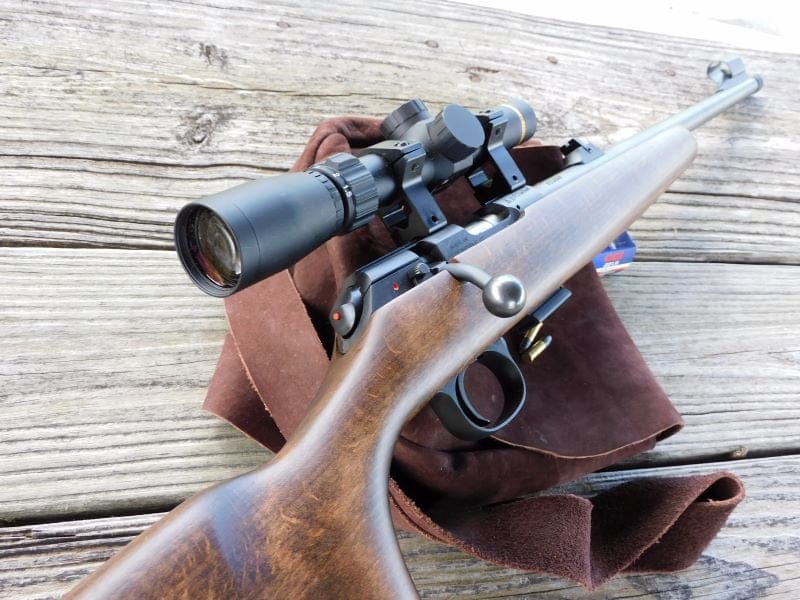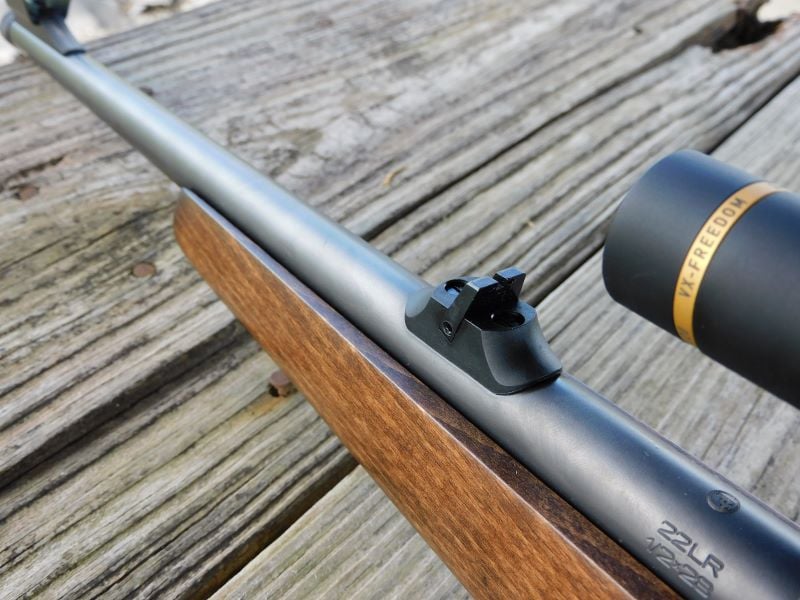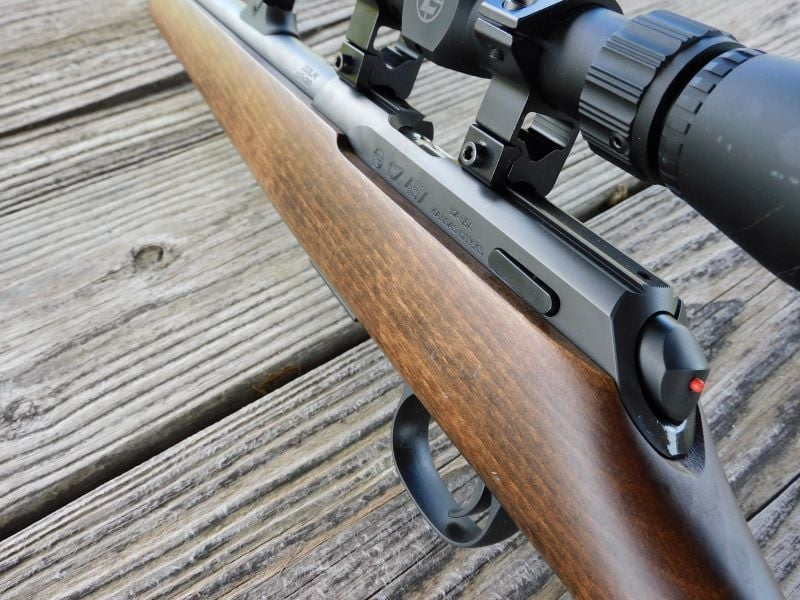If you are in the market for a 22 rifle, chances are you can find one to fit your needs. Although 22 rimfire and the rifles that shoot them used to be associated with a training aid, usually for young shooters, plenty of adult-sized models are available today. If anything, finding a quality youth trainer can be hit or miss. The CZ 457 might be your hit.
These rifles tend to be lighter than most, with short barrels, iron sights, and abbreviated polymer stocks to fit short shooters with short arms. They are often set up as single-shot rifles that must be loaded and reloaded one shell at a time. The Savage Rascal fits the description. As an adult, I packed a Keystone Arms Cricket for pest control because that single-shot bolt action was light to stash and tolerant of going unused for long periods of time but being ready at a moment’s notice. But for someone learning to shoot, these rifles are easy to outgrow and are not as fully featured as they could be. The CZ 457 Scout better fits the bill, and when I cruised the shelves at my local shop for my daughter’s first rifle, one example followed me home.

Features and First Impressions
The CZ 457 Scout is a dedicated youth rifle, and it appears that CZ attempted to market it as such not only in its abbreviated features but in its price tag. As a result, the Scout is the least expensive of its lineup, but it shows only slightly in the finished product. Out of the box, the first thing that catches the eye is the beech Monte Carlo stock—attractive and well-oiled—but not walnut. Likewise, the barrel and action are finished in a subdued, dull nitride rather than a high-polished blue. These are apparent cost-saving measures, but there is little to be missed in terms of looks and feel.

The CZ 457 Scout also features a milled steel trigger group, a push-forward safety, and a sixty-degree bolt throw. At the same time, the previous generation of rifles favored cheaper stamped steel, a Mauser-style flag safety at the rear of the bolt, and a ninety-degree throw that could sometimes interfere with an optic.

Familiarity with the CZ 457
Leaving that aside, the 457 Scout has the same familiar lines and action as the other rifles in CZ’s lineup, aside from having a shortened youth stock with a twelve-inch length of pull and a stumpy sixteen-inch barrel—perfect for short shooters and folks who can appreciate a handy little rifle. The Scout is set up out of the box as a single-shot rifle with a polymer block in the magazine well to make it easy to load one loose round at a time.

The Block
The block can easily be taken out, and the rifle can take any of CZ’s five to twenty-five round magazines to operate as a repeating rifle. The sights consist of a rear notch set inside a fixed base and a partridge front sight protected by a removable hood.

But like CZ’s other rimfire rifles, the top strap of the receiver is dovetailed for an 11mm groove to install an optic. The difference between the 11mm groove and a conventional 3/8 inch groove found on American rimfire rifles is a matter of the sharper internal diameter of the dovetail. As such, some 3/8 inch scope mounts will fit.

Knowing CZ’s reputation for good accuracy, I mounted a trim little Leupold VX-Freedom 1.5-4×20 scope in some Modkin aluminum 11mm rings I had on hand. Then, after procuring a few five-shot steel CZ magazines and sampling 22 LR ammo, I set out for the range to see what I could learn.
On the Range with the CZ 457
I started my range workout with the CZ 457, putting it on a rest, and set paper targets at fifty yards to zero my optic. With the single-shot adapter in the magazine well, I opened the bolt, dropped in one round, closed the bolt, and set about walking my pet ammunition, 40 grain CCI Blaser lead rounds, into one target one round at a time until I hit the center of my bullseye at that distance. With that done, I removed the adapter the same way one might remove the magazine by pushing forward on the magazine catch ahead of the well and pulling it out. I inserted one loaded five-round magazine and set about taking groups while shooting through my Caldwell chronograph.
| Ammunition | Muzzle Velocity (feet per sec.) | Five-Shot Group (Inch) |
| CCI Blaser 40 grain LRN | 1208 | .990 |
| CCI Stinger 32 grain HP | 1540 | .63 |
| CCI Copper 21 grain Solid | 1680 | 1.2 |
| Winchester West. 36 grain HP | 1248 | 1.0 |
| Federal Target 40 grain LRN | 1062 | .50 |
Groupings
In terms of raw group size, Federal’s Target Load—a 40-grain lead bullet standard velocity offering—performed the best with groups reliably printing near the one-half inch mark, close to zero. CCI Stinger loads, a hypervelocity load known for opening up tight groups, performed nearly as well, although those lighter rounds struck two inches high and slightly to the left from my zero. The CCI Blaser, essentially a CCI Mini Mag loading without a copper wash, came in under one inch, but removing one flyer, the group shrinks to only .38 of one inch. Finally, cheap and inconsistent Winchester Western 36 grain hollowpoints, my favorite pest control load, still yielded one-inch patterns at zero.

Unagreeable .22
Some 22 rifles simply do not agree with some ammunition. Still, with the exception of CCI Copper, it appears the 457 Scout shoots competitively with a variety depending on how you want to set the rifle up. And it certainly feeds all types. Working the bolt was smooth and effortless between shots, and I was scarcely off my optic and my target. There were no failures to fire after six hundred rounds downrange, and the only failures to feed came when I decided to experiment by loading the magazine with 22 Short ammunition. The magazine will feed with 22 Short ammunition, but there is too much room for the round to go from magazine to chamber throat.
When set up as a single-shot, there were no issues, and feeding was as instinctive as dropping a round on the magazine block and pushing the bolt forward to chamber the round. The inclusion of the magazine block is a great feature to teach new shooters one round at a time, but its inclusion also makes it easier to load rounds that simply won’t cycle through a magazine.
Parting Shots
There are plenty of good training rifles out there, but many are made to be functional but cheap. The 457 Scout leans toward the opposite end of the spectrum. It is still an easy-to-understand single-shot 22, but with an old-world taste. But the additional features of added magazine capacity, threaded barrel, and a set trigger lends pushes the CZ 457 Scout beyond the basic needs of a trainer into a more useful platform that new shooters can flex into and old shooters, like me, can enjoy, without lugging around a bunch of extra weight. While my daughter is still several years away from being behind this one, I am awfully tempted to buy another for myself when the time comes.

